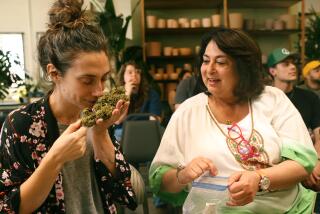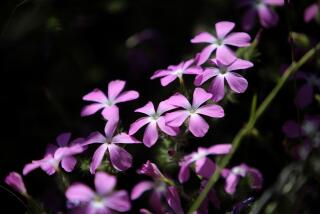Poppy culture
THE first wild poppies appear on the hills around Los Angeles in late December. A smattering follow in January, a surprising number bloom through the drenchings in February, then, boom, the hills and valleys turn into a euphoric gold carpet from March until June. Reflecting this swelling exultance of the wild in city gardens takes little more than a shake of the seed packet.
The trick is shaking it now.
Do it today, tomorrow, this coming month. This way, the poppy seeds have time to germinate and mature slowly through the rainy season. By the coldest dawns of late December or January, seedlings will be well enough established to survive frost, and by spring, the seemingly delicate flowers will have established long, robust tap roots full of food and water, all set for the spring flush.
Whatever you do, don’t wait for one of those helpful seasonal prompts from a home improvement chain. It won’t happen. Big-box stores sell much the same stock here as they do in Connecticut, so the fall planting specials invariably concentrate on tulips and daffodils. The Eastern bias is so strong that if you find seeds for our state flower at all at OSH, you will be doing well. At Home Depot, there should be native wildflower seeds, but they will be at the back of the store, past the pesticides. Only the ever-improving local chain Armstrong gives the wildflower seeds a strong display, if far from the entrance, again past the Dutch bulbs.
This is bad enough coming at the height of our season for planting wildflowers, but it is positively backward in a place where a poppy is the state flower, nevermind that the California poppy is an unsung star of international horticulture.
Nobody is quite sure when it first caught a European eye. James Curtis Clark, a professor of botany at Cal Poly Pomona, was stunned when he arrived in California from Oklahoma in the mid-1970s all set to work on his doctoral degree and found no major systematic studies of the California poppy. He’s since corrected that, and in a comprehensive website that he’s posted (teachers, hie thee hither: www.csupomona.edu/jcclark/poppy), he speculates that Juan Rodriguez Cabrillo, who set sail from Navidad, Mexico, in June 1542, must have seen virgin hillsides of Alta California still blushing gold during his trip up the coast.
However, it took Adelbert von Chamisso, who was on a Russian sailing expedition to California and Alaska in 1816, to collect the plant and name it after a German surgeon and entomologist traveling with him, Johann Friedrich Eschscholtz, thus rendering our state flower Eschscholzia californica.
By the 1840s, collectors were busily sending seeds from perhaps a dozen regional species of the California poppy back to Europe, says Clark. For more than a century, English horticulturists particularly have sown field after field of them looking for interesting variations -- spotting a pink one here, a frilly one there.
They then cross-pollinated the curiosities to produce only seeds with the desired mutation: only tufted, only pink, etc. The result: Look at the current catalog of the English seed company Thompson & Morgan, and the California poppies are as unrecognizable as relatives of our wildflower as a poodle is of a wolf. On its home page, the 2006 “top annual” is ‘Summer Sorbet,’ a California poppy with ruffled pink cup and cream-and-yellow throat. If it is yellow you fancy, there’s ‘Buttermilk.’ Coral? ‘Apricot Flambeau.’
There are some American dandies. The Colorado-based company Botanical Interests raises a lipstick-red ‘Mikado’ variant on the California poppy. For those Sissinghurst types, there is ‘White Linen.’ The Santa Cruz firm Renee’s Garden has the red-and-white mix ‘Tequila Sunrise.’
BUT nothing we have touches the versions in the English catalogs, which is perhaps just as well. A few potfuls of the Europeanized natives go a long way. Overdo the planting of Eschscholzia cultivars such as ‘Champagne and Roses’ or ‘Strawberry Fields,’ and the plants easily take on a faintly disturbing quality, as curiously wrong as fruit-flavored yogurt or a child with makeup. No, if you want the flowers along your front walk to echo the trumpeting glee of California spring, best to use seeds from the native wildflower.
Or as close as you can get to it. Out in Pomona, Clark warns that commercial California poppy seeds may be sold as wildflowers, but they too are plants that have been altered by breeders. Although American seed companies haven’t been as determined as Europeans to change the look of the state flower, they’ve still meddled profoundly with its habit. They’ve had to, explains Clark. Wild poppies may have a 5% germination rate with the first rain, allowing a successive germination throughout the season, and even delays lasting years.
No nursery could sell seeds with a 5% germination rate, says Stephen Knutson, chief executive of L.A.’s Stover Seed Co. His poppy propagators look for 85% germination, or almost simultaneous bloom. The moral: Use commercial seed only away from wild settings to avoid interbreeding, because what is a flaw in a cultivated poppy is the life-saving strength of the wild one. Gradual germination is nature’s version of not putting all its eggs in one basket. By reserving a largely dormant seed bank to bloom unpredictably over not just one season, but a series of years, wild seed ensures the future of the flower. Commercial poppies have no such defense. All it would take to wipe out a field, 85% of which germinate on cue with the first rain, would be one bad season.
The genetics of wild poppies are so finely adapted to location that subtle regional variations explain what are thought to be from eight to 12 other Eschscholzia species, depending on which taxonomist is doing the counting. These include poppies specific to the Sacramento Valley poppy, the Mojave Desert natives, the coast, the peninsular ranges and a stunning, deep orange Tehachapi poppy E. lemmonii.
Respecting these differences means that even Caltrans stops spreading its standard wildflower seed mix for roadside erosion control and instead painstakingly handpicks native seeds near wild stands of our state flowers, says one of the agency’s landscape architects, Haiching Pan.
However, most of the poppy seeds sold and sown in California are anything but locally produced. Outsourcing was the standard in the flower seed business before most of America knew the word. Wild seed originally collected here hasn’t been home in decades. Once Holland was a key supplier of poppy seeds. However, the Netherlands is becoming too expensive, says Caltrans supplier Jody Miller, manager of S&S; Seeds in Carpinteria. Her company’s suppliers now propagate the seeds wherever it’s cheapest: “California, Europe, India.”
Even if you are shopping at the echtest of the echt native nurseries around Los Angeles, such as the Theodore Payne Foundation in Sun Valley, the California poppy seeds you purchase will probably not come from California. Payne gets its poppy seeds from Stover, whose seeds are propagated in Oregon. The reason for flower gardeners to make a trip out there isn’t for seeds suitable for wilderness restoration, but the chance to root around Payne’s seed drawers to create their own wildflower mix. Go on a weekday for best access to the drawers. Peigi Duvall, director of the horticulture program for the California Native Plant Society, suggests tossing in some Clarkia, Gilia and lupines.
To its credit, Stover does good native wildflower mixes sold in 12-ounce packets at Armstrong Garden Centers and Home Depot, including ones that take shade.
Whether the cultivated poppy seeds sold even in the best garden centers will in fact naturalize once planted in the garden depends on when and where you plant them. Autumn-sown poppies have a strong spring bloom and the best chance of setting seed. Poppies sown in the spring have the worst. They may flower once before heat and drying soil beats them back into the earth.
When it comes to pollination duties, European honeybees have taken up much of the work originally done by native insects, primarily bumblebees and beetles. But their small size makes them inefficient. They can carry off the nectar without picking up pollen. Because of the open, make that frankly casual, structure of the flower, the bigger the bug, the better the pollen transfer and fertilization, says James N. Hogue, coauthor of “Introduction to California Beetles.” (Read Hogue’s book, and one realizes that it is probably not a coincidence that Eschscholtz’s traveling companion of 1816 discovered the poppy: Eschscholtz was a tenacious beetle collector.)
CLARK has noted that because poppies have a light-driven habit of opening their petals early in the morning and closing up as soon as the sun begins to lower, beetles often become trapped in the closed flower overnight. They don’t seem to mind. Poppies may even be an important beetle shelter.
Clark frequently is asked how many seeds a single poppy flower produces. California’s presiding authority has never counted, he says. “I would crudely estimate between 30 and 200.” To collect them, watch for the ripening pod. Petals fall from poppies shortly after pollination. “Unripe pods are green and glossy,” he says. “As they mature, they turn to a duller green and sink in between the ridges.”
One way to test is to pull a pod off. “If the seeds are black, they’re mature,” he says. “Pull the seed pods off, put them in a paper bag, allow them to continue to dry and they pop open on their own.”
Or you could do as Stover growers do, and line the earth around the flowers with a tarp, then thresh and sort the whole garden.
Whether a poppy lasts more than one season or dies back after setting seed depends on the soil, situation, timing and subtle variations in the genetics. Clark has studied wild populations of poppies in the Antelope Valley growing side by side in which one is perennial, the other annual. For the garden, perennials save replanting every year, but the older plants can get a bit leggy.
A specialized concern among poppy fans is: Which species of poppies transplant most equably? Caught young, most poppies endure transplanting, though they sulk briefly. It’s fine for filling a window box, but planting a bed that way can feel a bit involved, like a Bosley hair transplant. A way around it is to simply sow lavishly, as if you were out to show the inhabitants of Oz how it’s done, then thin the seedlings, trying not to be too weepy about it.
There are those who mix the seeds with sand to get better distribution, and save on thinning. If you have the sand, fine. If not, get a-sowing anyway. A scatter and light sprinkle will help sink the seed just enough to take. Then poppy seeds are best ignored. Retreat inside for the winter. Even allowing a portion of the seeds for a passing mouse, California gold will await you next spring.
Emily Green can be reached at emily.green@latimes.com.
More to Read
Sign up for The Wild
We’ll help you find the best places to hike, bike and run, as well as the perfect silent spots for meditation and yoga.
You may occasionally receive promotional content from the Los Angeles Times.






